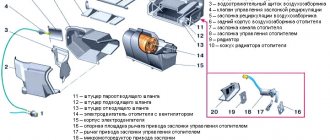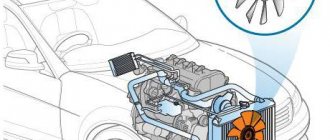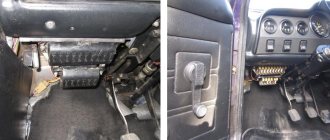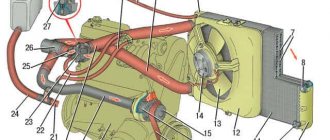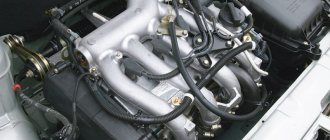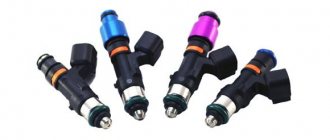What are the causes of floating idle: faulty VAZ injector
The reasons for the floating idle, the VAZ injector and its malfunction, as one of the possible reasons - such questions concern many car enthusiasts. When a breakdown occurs in a beloved car, the owner experiences the same worry as if he himself was sick. And therefore, while traveling, from time to time he listens to see if the car is working normally, if there are any suspicious extra noises.
What are the reasons for the floating idle speed of vases?
Why does the speed of the VAZ-2114 jump when the engine is cold? Sometimes the engine begins to behave atypically if the idle speed fluctuates. Owners of a VAZ car know that such a situation may arise, since this is typical for domestic cars.
Unstable idle: what is the reason? There are the most common reasons for this phenomenon, and knowing them, you can easily navigate and decide what to do.
From time to time the motor, which is in warm-up mode, begins to rotate at an unstable frequency, trots, and vibrates. If there are strange popping noises in the muffler, this indicates that the fuel mixture has become over-rich in the muffler, and if such problems appear in the carburetor, then the mixture is over-lean.
The instability of the speed mainly depends on the fuel mixture that enters the cylinders at idle speed in the VAZ. If the idle speed with a cold engine malfunctions, it is possible that a foreign body has entered, a small speck in the channel is enough.
The problem may arise from the idle speed sensor. To study this unit, you need to try to remove the VAZ from speed at idle. If it does not stall, the heater and headlights turn on. If the speed does not drop, then everything is fine in this part. But if there is a problem in this part, it means that the adjustment was made incorrectly, and therefore the fuel mixture is lean at idle.
Is it worth it to blame the carburetor?
The car may stall at idle due to problems with the carburetor If you have a carburetor engine, then 9 out of 10, the car stalls at idle precisely because of problems with the carburetor. The simplest option is that it is clogged. In part, this is a very simple and reliable element, but it needs to be cleaned constantly.
Any speck that has leaked through the filter system can seriously ruin the operation of the engine and raise many questions not only in the mind of an amateur, but also among service station specialists.
It is recommended to wash the carburetor in special solvents, which are easy to purchase at auto supply stores. The aforementioned aerosol cleaner will also come to the rescue.
How to adjust idle speed
The speed can be adjusted using screws. They are available on carburetors specifically designed for VAZ. A floating idle may occur if there is a malfunction in the mass air flow sensor.
In all cases, it needs to be replaced and the contacts cleaned, even if there is the slightest oxidation.
If the sensor responsible for the crankshaft position is faulty, the first thing to do is check the wires that go to it.
If no damage is noticed here, a multimeter should be connected to the sensor, and the crankshaft should be set so that it is in a position where the highest voltage is 200 mV. If you pass a screwdriver over the core and voltage surges are shown on the device screen, the sensor is in good condition and works normally.
Injector malfunction as a cause of floating idle
There are other reasons for the malfunction. If the speed drops on a VAZ-2115 or 2107, the throttle assembly may be faulty, and the reason may be hidden in the throttle valve. If it has difficulty moving, it needs to be removed and cleaned. The sensor that records the position of the injector requires measurements. You need to find out the voltage between the minus and the slider contact.
When the injector on a VAZ-2107 is closed, the voltage in this case should be 0.7 V. When it is open - 4 V. If the numbers are incorrect, the sensor must be replaced. On the VAZ-2115, the injector is often the source of a malfunction, so the throttle assembly must be cleaned.
When the previous systems are in order, you should check the idle air valve solenoid. His revision is that first of all the power is turned off and after that the car starts. To check, the wire is brought to the negative contact and to the positive one. There should be a click. If there is no click during these actions, it means that the valve is not working, and because of this the idle speed is floating.
Self-diagnosis in the garage
If you have problems with the operation of the injection system, you should first diagnose the ECU. In this regard, the owners of the VAZ 2114 are more fortunate with the German VDO instrumentation - it has a self-diagnosis mode. On cars with a dashboard from Schetmash there is no such functionality.
VDO dashboard for VAZ 2114
Working with the self-diagnosis mode on the VDO panel is carried out according to the following algorithm:
- With the ignition off, hold the odometer button for several seconds;
- turn the ignition to position “1”, release the button;
- if the arrows start running on the display, everything is fine, press once (information message about the firmware version) and release, with a second press an error code will appear;
- You can reset the error by holding the button until “0” appears.
Injection problems that cause the car to stall can be indicated by the numbers 1 (ECU error), 14,15 (coolant sensor errors), 22, 23 (DPS errors), 33, 34 (MAF errors), 42 (ignition malfunction) , 44, 45 (lean or rich mixture). The disadvantage of self-diagnosis on the VAZ 2114 is that if there are several errors, the system sums up the codes. Thus, the number “22” may mean a TPS error or low on-board voltage and a coolant sensor error (8 + 14).
For more accurate diagnostics of the injector, you need to immediately contact a service center or purchase a diagnostic scanner (it costs about 1000 rubles).
If you have another car, you can find the problematic sensor by replacing the sensitive elements one by one with known good ones.
Why does the VAZ-2114 have variable speed when the engine is cold?
It is not so easy to immediately determine the specific reason why the VAZ-2114 idle speed fluctuates. Operating such a car is not only inconvenient (you have to constantly monitor the speed and keep your foot on the gas pedal, preventing the car from stalling), but also fraught with consequences, for example, engine water hammer. If you neglect this problem, you can get a serious engine malfunction, the repair of which will cost a tidy sum.
The car does not start for a long time and stalls immediately after turning off the starter
Sometimes it happens that the engine either refuses to slow down when you release the gas pedal, or, on the contrary, suddenly stalls at idle. A significant proportion of these cases are due to a faulty engine throttle valve. In other words, it is clogged and jammed.
This can occur due to prolonged driving on low-quality fuel, of which we have plenty, as well as from dirt impurities in the air entering through the air filter.
This problem can be mitigated by regular cleaning of the throttle valve. To do this, it is recommended to use a universal cleaner for purging carburetors and other car parts; it comes in metal cans and is sold at any auto supply store. It is also worth paying attention to the inevitable clogging of the oil trap in the crankcase ventilation system, as this is just a matter of time. If the filter becomes dirty, the engine literally begins to choke from excess crankcase gases, as a result of which it does not hold idle speed and stalls. The crankcase ventilation filter must be washed regularly.
List of main reasons
Reasons why idle speed fluctuates
Incorrect operation of the power unit may be caused by a malfunction of certain elements:
- Failure of sensors:
- RXX;
- DMRV;
- DPKV;
- Lambda probe;
- DSA.
- The XX solenoid valve is faulty;
- The air filter is clogged;
- Heavy carbon deposits on candles;
- High-voltage wires are damaged or oxidized;
- Air leak in the intake manifold;
- Incorrect throttle position.
Device
In 2000, the VAZ 2115 evolved. The carburetor was replaced by an injector. In subsequent years, with a difference of 7 years, the “fifteenth” models were equipped with 2 types of engines:
- 8 valves (1499 cm³, 71.6 hp);
- 16 valves (1596 cm³, 80.9 hp).
A stepper idle speed controller was installed on both motors. This is a mini-electric motor that opens/closes the air passage of the intake manifold, thus regulating the enrichment or leanness of the fuel mixture (similar to a bolt on a carburetor).
Inside the IAC there is a ring magnet, 2 windings and a lead screw (needle). Under voltage, an electromagnetic field appears in the windings, as a result of which the rotor begins to rotate in one direction or the other, pushing the needle forward/retracted along the worm gear. At the end of the needle there is a valve that opens/closes the air duct on the intake manifold.
What is a step? This is the distance between the conical shut-off valve (IAC tip) and the intake manifold, which is measured by the number of complete revolutions of the rotor.
Do-it-yourself troubleshooting
Many faults from the above list can be eliminated yourself in a few minutes. It will take much more time to identify.
Diagnostics of mass air flow sensor and IAC
The mass air flow sensor and idle air control act as regulators of air supply to the combustion chamber.
Failure of these sensors will lead to an increase in fuel consumption, and a broken rod will affect the speedometer needle; it will remain motionless until the problem is fixed.
Diagnosis of DPCV
Crankshaft rotation sensor location
Failure of the crankshaft position sensor will negatively affect the operation of the engine as a whole. A failure in synchronization between the engine and the injection system will result in the car not starting. You can accurately determine the condition of the sensor only by using a multimeter.
To do this you need to do the following:
- Set the position on the sensor with a maximum value of 200mV;
- Connect the multimeter and close the core with a screwdriver;
Checking DPKV with a multimeter
Video about checking the crankshaft rotation sensor
Lambda probe diagnostics
Location of the oxygen sensor (lambda probe)
The sensor reads the amount of oxygen in the exhaust gases and sends a signal to the computer to increase or decrease the air supply to the combustion chamber. Diagnostics is performed with a multimeter on a warm engine. The procedure is as follows:
- One core of the device clings to the ground, the second to the output from the sensor;
- When re-gassing the engine, the multimeter readings should be in the range from 0.2 to 0.9 V;
When checking the lambda probe, the voltage readings should be within 0.2 - 0.9V
Video about checking the lambda probe
Speed sensor diagnostics
The vehicle speed sensor is located in the gearbox. Its diagnosis is carried out by visual inspection of wires and contacts . If oxide is detected, it must be thoroughly cleaned.
Replacing the air filter and glow plugs
Air filter for VAZ-2114
The presence of a large amount of dust on the body and inside the air filter requires its immediate replacement.
Since its throughput is reduced, the engine does not have enough air in the combustion chambers . Due to this, the fuel does not burn completely, and the remaining fuel is thrown out and burns out in the exhaust pipe, which can burn out as a result.
Heavy carbon deposits on the spark plugs or any mechanical damage to the housing require their replacement.
Oil deposits on spark plugs
Important! If the machine was operated with this malfunction, it is recommended to replace the spark plugs, since, due to high fuel consumption, they will be flooded.
Checking wires
The easiest way to diagnose high-voltage wires is in the dark; to do this, just open the hood. If the wire is “broken,” a spark will be visible striking to the side .
Visual inspection of high-voltage wires
Another reason lurking in this place is poor contact, the appearance of oxide. To do this, you need to visually evaluate the wire tips (white, blue or green coating); you need to thoroughly clean them, wash them with Wedge (WD-40), dry them and put them in place.
Healthy! Don't forget about the term "metal fatigue". This refers to the deterioration of current conductivity due to the fact that the contacts are in constant voltage mode. Therefore, high-voltage wires should be periodically replaced with new ones (their specific service life depends on the manufacturer and is indicated on the packaging).
Checking the intake manifold
Most often, air leaks occur through the connection of the intake manifold to the cylinder block . This happens due to wear of the gasket. This is not difficult to identify. To do this, you will need regular carburetor cleaner. With the engine running, you need to spray the can on all connections and places that cause you suspicion (microcracks in the commutator body itself are also possible).
Checking the intake manifold
If the engine runs without changes, then the cause of the malfunction is not here. If the engine speed increases and the engine jerks, the manifold or intake manifold gasket should be replaced.
Healthy! There is no need to solder and glue the intake manifold. The patch will not stay in place for long and after a while the problem will arise again.
Cleaning the throttle valve
The throttle valve needs regular cleaning of carbon deposits.
Due to heavy carbon deposits, the throttle valve may be in an incorrect position. To fix this, you will need to remove the throttle assembly and clean it with a carburetor cleaner or carburetor cleaner, and then reinstall it.
Healthy! The assembly should be washed thoroughly; you can soak it in gasoline for a while.
Floating speed is a standard disease of injection engines. The fact is that the ECU, when receiving an incorrect signal from a non-working sensor, mistakenly opens the air supply solenoid valve . The TPS gives a signal that this cannot happen, and the engine has already left the warm-up mode. It is at this moment that the idle speed of the VAZ-2114 begins to float. Therefore, if such a problem appears on your car, do not be upset. If the cause is detected and eliminated in a timely manner, there is nothing to worry about.
Ignition module
Another problem is the ignition module. This malfunction was more common on cars of the Samara-1 generation. In the case of Samara-2, the quality of the part itself has improved, but the root of the problem remains. The module is attached to the cylinder block, which causes it to get very hot and burn out the windings. As a result, when hot, it is possible to lose spark in one, several or all cylinders at once.
If the car does not start when hot, check the spark. If it doesn't, that's almost certainly the problem. You can usually resolve the issue by replacing the module, but if the problem returns, consider moving the bracket to another location. Most often it is installed in the front part of the engine compartment, near the radiator.
Most problems with poor engine starting when hot are solved using these methods. But less probable ones are also possible: broken wiring, ECU malfunction, etc.
